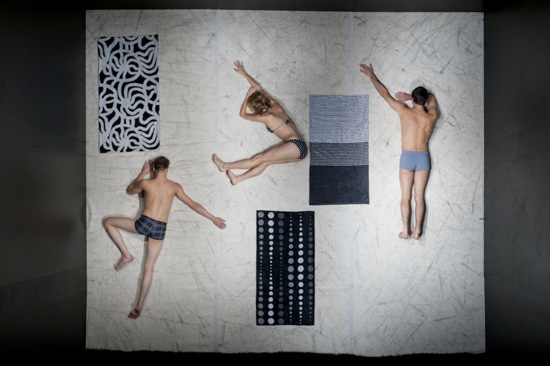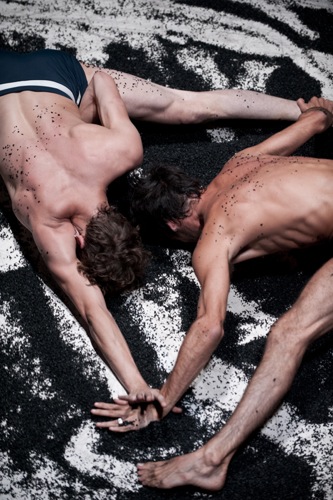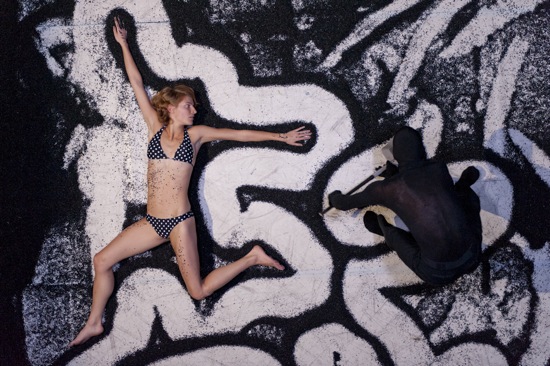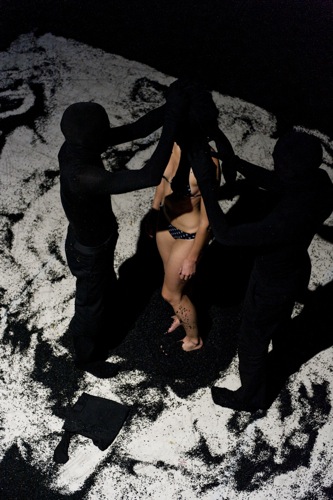Compagnie Philippe Saire brings Black Out to LaMama

This is how it begins: Philppe Saire’s Black Out. (L to R): Jonathan Schatz, Maëlle Desclaux, Philippe Chosson. Photo: Philippe Weisbrodt
Black Out, a creation by Philippe Saire, mates choreography with visual art in ways calculated to disturb us. He is frank about his mission, describing Black Out as “A work that contemplates the randomness of mortality in a world of genocide, disease, epidemics, and senseless violence.”
In it, three collaborating members of Compagnie Philippe Saire (based in Lausanne, Switzerland) function as both designers and performers; they alter and modify their environment, all the while adapting to forces beyond their control.
The stunning work is resonant with possible interpretations, and these fluctuate over the piece’s 40 minutes. The set has completely transformed the Ellen Stewart Theater at LaMama. We must enter the semi-dark space, and, guided by a flashlight, mount a flight of stairs at the far end. Once there, we take our places around a barricaded square—about twelve of us to a side. With wooden fencing behind us to prevent our falling off, and more in front of us on which we can rest our elbows, we stand, packed shoulder to shoulder, for the duration of the piece.
Our focus is directed downward into what might be a miniature, contemporary version of a pit for bear-baiting. Yet, given its white floor and the bright light initially trained on it (lighting by Yan Godat), we might as easily imagine it to be a sun-baked beach, where Philippe Chosson, Maëlle Desclaux, and Jonathan Schatz have decided to get a tan. A towel spread beside each adds to the almost two-dimensional look of the image. At first, the three barely move; Chosson, lying face down, makes the fingers of one hand squeak against the floor, while Stéphane Vecchione’s sound design offers a faint, repetitive pattern of tickings. For a while, the performers adjust their positions as economically as possible. I begin to think that there’s really only one position—lying supine with one arm draped over the eyes—which they turn and twist and rotate in individual ways. Now they’re belly-down, now they’re jack-knifed on their sides, frozen in mid-transition. At first, they move slowly, inch-by-inch, pausing for long moments. In the virtual distance, a brass band plays a dead march that is gradually swallowed by other less musical sounds.
The people’s moves become bolder, and a new activity develops. On hands and feet, they propel the towels around. Then without warning, a storm subverts this dreamily re-arranging-itself painting and swerves it toward drama. Black granules pour down in one spot, some spattering onto the performers. Another load falls, and another, and another, just missing the residents of these cramped quarters. After a brief rest in a human pile, the three cope with what we sense as a disastrous environmental change.
Chosson, Desclaux, and Schatz become far more intimately involved with what becomes their “material” than Jackson Pollock was with his. He flung paint onto a canvas while walking around it at a more or less safe distance. These dancers integrate themselves into an artwork that may (do they imagine this?) make the unnatural disaster manageable. They kick the granules (tiny pellets of black rubber) around. Chosson and Schatz use each other’s hands and feet as brooms—crawling and slithering over the floor together, each grasping and manipulating now one of his partner’s body parts, now another. Their sweeping actions bare curving white shapes beneath the black. As all three walk across the floor, sliding their feet along, they overlay snaking designs with sharp, straight lines, then with basket-weave. The arena amplifies and feeds back the sounds. Some cultures create elaborate sand paintings that aren’t meant to last, but the ones made by these dancer-painters are destroyed almost immediately.
At some point, the confined black-walled space begins to seem imprisoning. We could be voyeurs, or amateur scientists observing an ant colony going about its business in a transparent box, or detectives watching an interrogation through one-way glass. What are we to make of the long row of piled-up granules that lies almost invisibly against one of the walls? And the shovels that appear? How does Chosson contrive to disappear? Then Schatz?
The relationship among the three changes, shifting from that of three collaborating workers to that of two artists (?) and their model. I can no longer distinguish between the men, because when each reappears, he not only casts a black shadow, he is one. Every inch of him (face included) is covered by a black fabric skin. Desclaux has occasionally looked up, as if fearing more precipitation from above; now she races about, banging against the walls and eventually falling at the feet of one of the men (Schatz, I believe). With a little trowel he piles up granules around her splayed form and then uncovers fat white worms of flooring to amplify the design, working in a frenzy. The chalked outline of a murder victim? Or just a piece of postmodern performance art? The lights brighten to a glare, then go out.
The situation changes again, worsens. Head on a pile of the debris, Desclaux attempts to push it away, backs off, tries again. Now we have to confront the enormity of what seems to be turning into a ritual murder. Chosson (I think) brings a bundle of black rags to Desclaux; it turns out to be a suit like the ones he and Schatz wear. Painstakingly they fit it onto her and smooth the hood over her head. Then they lay her on her back in the center of the space and arrange her limbs.
Seizing spades out of the darkness, the men shovel load after load of pellets over her. A current seems to run through the rapt spectators. A woman near me whimpers under her breath. Working rapidly, the black shadow-men cover Desclaux’s legs, her arms, her body. . .her head (please, no!!). By the time they’ve finished, she is invisible, entombed in a neat black catafalque. How many of us are holding our breaths, wondering how long she has to hold hers? If there is a hidden pocket of air for her, it’s not apparent.
Fortunately for all concerned, we can, after a few agonizing minutes, see her beginning to move under the black load, but that’s seconds before the lights go out. And stay out. We can just make out the fact that the floor below us is getting more uniformly dark; a few tiny lights suddenly stud it. Has the sky fallen? When the overhead illumination finally comes on again, the white floor has turned completely black. Suddenly, I think back to the beginning of Black Out, and my memory of it changes; the valiant performers and their poses now summon up figures from ancient Pompeii, felled as they worked or slept, immobilized in volcanic ash. Brutality. Devastation. This is the way the world ends.




What an exciting piece that sounds like. Wish I could see it. The audience set-up is similar to Andrzej Grotowski’s when he directed “The Constant Prince” in Wroclaw before he left Poland.